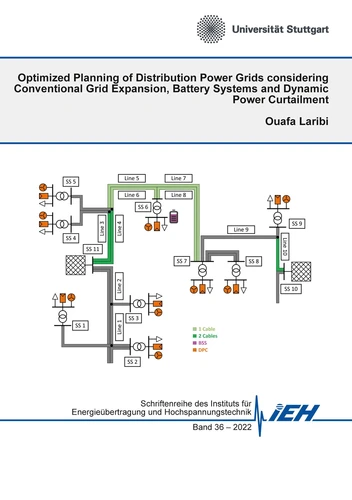Optimized Planning of Distribution Power Grids considering Conventional Grid Expansion, Battery Systems and Dynamic Power Curtailment
Par :Formats :
Disponible dans votre compte client Decitre ou Furet du Nord dès validation de votre commande. Le format PDF est :
- Compatible avec une lecture sur My Vivlio (smartphone, tablette, ordinateur)
- Compatible avec une lecture sur liseuses Vivlio
- Pour les liseuses autres que Vivlio, vous devez utiliser le logiciel Adobe Digital Edition. Non compatible avec la lecture sur les liseuses Kindle, Remarkable et Sony
 , qui est-ce ?
, qui est-ce ?Notre partenaire de plateforme de lecture numérique où vous retrouverez l'ensemble de vos ebooks gratuitement
Pour en savoir plus sur nos ebooks, consultez notre aide en ligne ici
- Nombre de pages148
- FormatPDF
- ISBN978-3-7568-7052-3
- EAN9783756870523
- Date de parution08/12/2022
- Protection num.Digital Watermarking
- Taille9 Mo
- Infos supplémentairespdf
- ÉditeurBooks on Demand
Résumé
The increasing integration of renewable energies is driving the transformation of the power grid in Germany. Renewable energy sources, which are mostly allocated in distribution grids, are replacing fossil power plants, that are mostly applied in the transport grid. This shift to more renewable energies entails the expansion of the power transport capacities in the distribution grid. The conventional expansion of the power grid in Germany is, however, proceeding slowly, due to the delay in the authorization procedures.
Therefore, new solutions that enable a higher utilization of the existing grid must be adopted besides the classical grid expansion in order to achieve the planned energy transition goals. This research work presents a new grid planning method which applies innovative technologies, in addition to the conventional planning instruments with overhead lines and cables, to optimize and expand the existing grid.
The innovative planning instruments considered are battery storage systems and dynamic power curtailment. The proposed approach has been implemented in a time series based framework as an automated planning algorithm. Based on the selected planning instruments, the planning algorithm determines for a given distribution grid the tailored and most cost-efficient measures to prevent prognosticated grid congestion.
Therefore, new solutions that enable a higher utilization of the existing grid must be adopted besides the classical grid expansion in order to achieve the planned energy transition goals. This research work presents a new grid planning method which applies innovative technologies, in addition to the conventional planning instruments with overhead lines and cables, to optimize and expand the existing grid.
The innovative planning instruments considered are battery storage systems and dynamic power curtailment. The proposed approach has been implemented in a time series based framework as an automated planning algorithm. Based on the selected planning instruments, the planning algorithm determines for a given distribution grid the tailored and most cost-efficient measures to prevent prognosticated grid congestion.
The increasing integration of renewable energies is driving the transformation of the power grid in Germany. Renewable energy sources, which are mostly allocated in distribution grids, are replacing fossil power plants, that are mostly applied in the transport grid. This shift to more renewable energies entails the expansion of the power transport capacities in the distribution grid. The conventional expansion of the power grid in Germany is, however, proceeding slowly, due to the delay in the authorization procedures.
Therefore, new solutions that enable a higher utilization of the existing grid must be adopted besides the classical grid expansion in order to achieve the planned energy transition goals. This research work presents a new grid planning method which applies innovative technologies, in addition to the conventional planning instruments with overhead lines and cables, to optimize and expand the existing grid.
The innovative planning instruments considered are battery storage systems and dynamic power curtailment. The proposed approach has been implemented in a time series based framework as an automated planning algorithm. Based on the selected planning instruments, the planning algorithm determines for a given distribution grid the tailored and most cost-efficient measures to prevent prognosticated grid congestion.
Therefore, new solutions that enable a higher utilization of the existing grid must be adopted besides the classical grid expansion in order to achieve the planned energy transition goals. This research work presents a new grid planning method which applies innovative technologies, in addition to the conventional planning instruments with overhead lines and cables, to optimize and expand the existing grid.
The innovative planning instruments considered are battery storage systems and dynamic power curtailment. The proposed approach has been implemented in a time series based framework as an automated planning algorithm. Based on the selected planning instruments, the planning algorithm determines for a given distribution grid the tailored and most cost-efficient measures to prevent prognosticated grid congestion.



